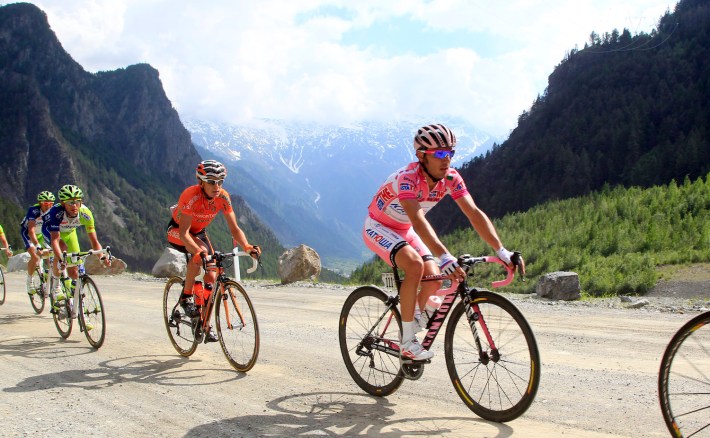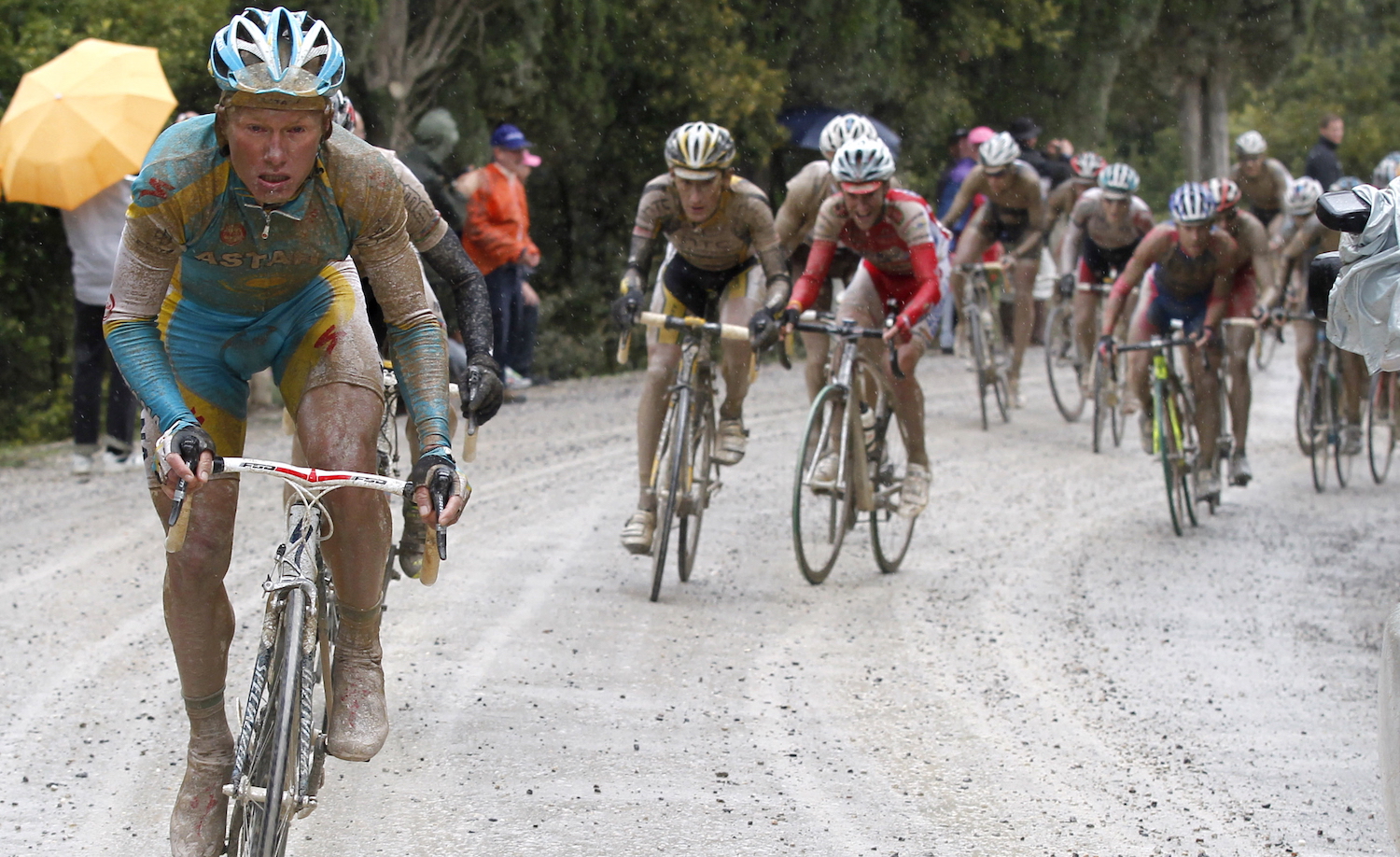Every major bike race has a suite of distinguishing features that elevate it from "a bunch of people riding around on some roads" to something more special. The Belgian classics revel in throwing riders onto gnashing cobblestones and narrow farm roads. The Tour de France has soaring Alpine vistas and a meaningful connection with 12 decades of history. Milan-San Remo is significantly longer than any other one-day classic, and inhospitable early season weather guarantees rugged racing. The Giro d'Italia already stands out for its gorgeous Dolomitic climbs and raucous crowds, though this past week's racing has highlighted another, newer feature that has become one of the most exciting terrains for road racing: gravel.
Tuscan wine country is interlaced with a dense network of gravel roads, which take on a striking white color thanks to the limestone-rich geology of the region that makes it such a prolific and famous area for wine cultivation. The strade bianche connect villages and other parts of the countryside, and they also attract so many riders and wine-drinkers that they have become a reliable part of Tuscany's tourist economy. Despite their beauty and symbolic importance, the history of organized racing on the gravel roads is surprisingly short. A popular amateur ride/festival called L'Eroica Strade Bianche began in 1997, with organizers requiring all attendees to ride "vintage" rigs—defined as bikes made before 1987—once the popularity of the ride took off. L'Eroica's quick success sparked the creation of a professional race of the same name through the area in 2007, featuring a lengthy tour through the dusty (and that's if you're lucky) white roads and a stunning uphill finish in Siena's Piazza del Campo.
Strade Bianche (the race's now-truncated name) has enjoyed a rise to prominence wholly unseen in the modern era of cycling. This sport tends to be more wedded to its history than almost any other, partially because that history is so rich and partially because today's stars compete on the exact same terrain as the legends did. Peter Sagan conquered the same cobblestones of Arenberg Forest in 2018 that Eddy Merckx did in 1970. Strade Bianche is about 100 years younger than any of cycling's five monument classics and it evolved from an elevated group ride, yet it's solidified itself as a monument-tier race within 14 years, pretty much exclusively because the racing is so good and so beautiful. Its list of winners is as elite as it is short, and bike knowers are already calling for it to be enshrined as the sixth monument. As original L'Eroica organizer Giancarlo Brocci told Cyclingnews, "It is heroic, because it has rediscovered those magnificent roads without asphalt where the special qualities of the rider still make the difference, such as skill, courage, dexterity, deciding at a glance, the ability to suffer."

Brocci is right. Racing on gravel, especially while doing so on a road bike, is wholly different than racing on any other terrain. It's most frequently compared to riding the cobblestones, for which the Tour de France has a growing fondness, but cobblestones are jarring to the point that most riders just try to survive rather than attack. Italian gravel roads are both significantly faster and more topographically varied. They undulate with the terrain, requiring anyone who wants to emerge unscathed to handle themselves capably on the downhills while also cranking out high wattages on the climbs. Gravel demands a constant vigilance, because unlike on the road, disaster could strike at any time, and teammates can only protect you so much. It's an equalizing force.
The highest levels of cycling have never been more specialized, with general classification contenders rarely finding themselves without several teammates on any terrain save for the most selective climbs. The sport is at heart always going to be a fitness competition, but any wild card like gravel is a welcome interruption simply because it tests a more diverse set of skills than "keeping a high power level for 45 minutes." Unsurprisingly, the inclusion of gravel segments has proven quite controversial. Giro organizers first wedged almost 20 kilometers of gravel roads into Stage 7 of the 2010 race, on a day it happened to be pouring rain. This made for a chaotic, muddy race, one that's gone down as one of the most memorable Grand Tour stages of the century. Not that the participants loved it as much as audiences, with Alexander Vinkourov saying, "The last 45 km were worse than Paris-Roubaix. I don’t think there's a place for dirt roads like this in a stage race like the Giro. In a one-day race yes, but not in a stage race."
This year's Giro d'Italia is just coming off two stages with gravel sections, rough riding that wedged open the biggest gaps yet between contenders for the maglia rosa. Colombian Egan Bernal won Stage 9 and seized the leader's jersey with a huge attack on the concluding gravel climb, and he sounds like the only team leader who's anything close to comfortable with the harsh terrain. Two stages later, Bernal solidified his grip on the jersey and put meaningful gaps in front of everyone chasing him. Belgian hotshot Remco Evenepoel in particular had a hard time on the gravel, ripping his earpiece out in frustration when he found himself without support from his teammates.
Raw power! 🤯 Relive the final gravel sector of Stage 9, with ramps up to 14% and @Eganbernal going off like a rocket! 🚀@INEOSGrenadiers #Giro104 #Giro2021 #Giro #giroditalia pic.twitter.com/AKZJAJ77yx
— Velon CC (@VelonCC) May 16, 2021
This is right in the sweet spot of arduous and thrilling. Boldness is rewarded, and those who aren't comfortable taking risks or riding hard on the inhospitable gravel roads find themselves distanced. There are obvious downsides to the chaos: The chances of a crash or mechanical issue derailing any rider's chances at any time is higher than on the road. Gravel racing demands a unique type of suffering, though unlike cobblestones, it's survivable enough that non-specialists can actually do a bit of racing. Irish stalwart Dan Martin captured the dynamic well after he lost seven minutes and a top-10 spot on Stage 11. "Cycling's not worth the risk [to me]," he said. "My license is road cycling, it's not my thing, but fair play to the guys in the front. The cycling fan in me thinks it's a beautiful stage."





